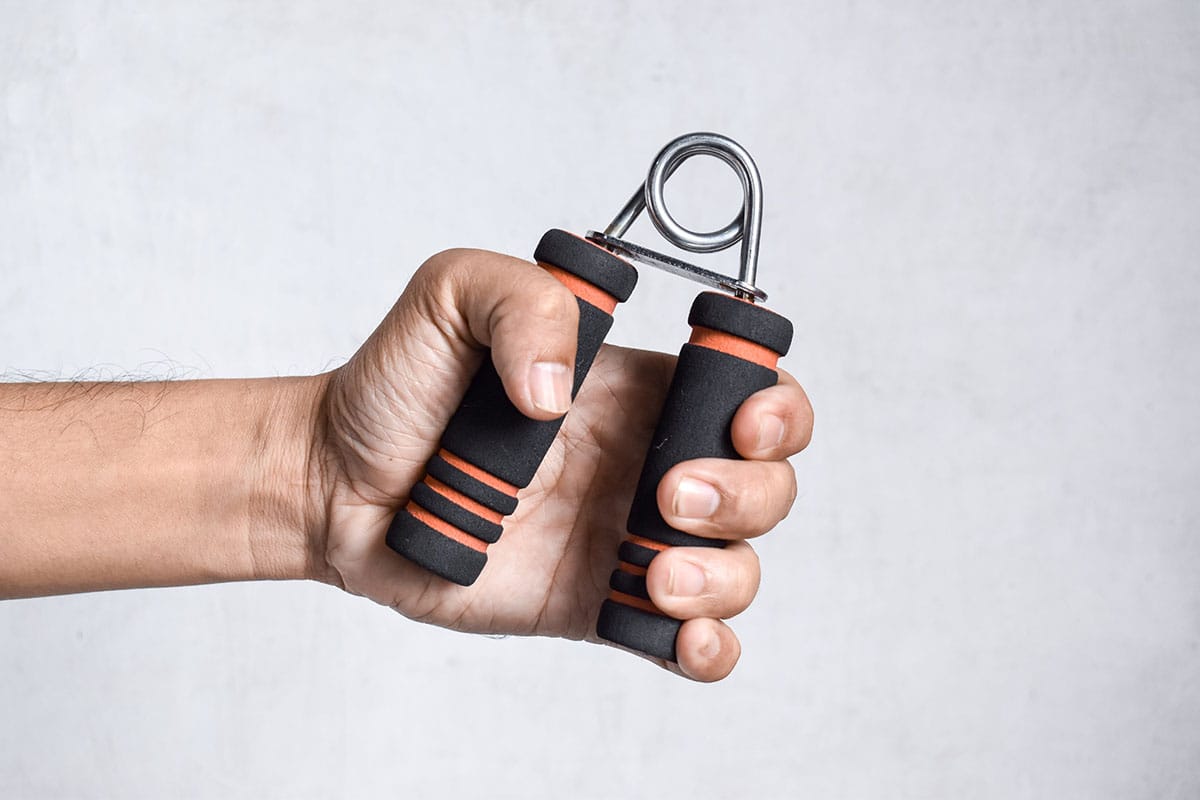Do Grip Strengtheners Work? Types and Benefits
Struggling to hold your weight in a pull-up? Fearful of dropping your barbell as you deadlift? Maybe you can feel your weights (and PRs) slipping through your fingers, quite literally.
In this case, it’s possible that you have weak grip strength. In this article, we’ll look at solutions on how to improve your grip. Get to know the three grip strength types, how to build them up, and what they’re used for.
We’ll also look through the 5 best grip strengthens of 2024 and answer the question, “Do grip strengtheners work?”
If so, who should and shouldn’t use them, and what role do they play in a strength training program?
Do Grip Strengtheners Work?
Hand grippers, also called grip strengtheners, are used to improve your hand grip strength. They are often used as a test in physiotherapy settings to assess grip strength and determine appropriate treatment for individuals with weak grip or medical conditions affecting grip.
Usually, this test is for what’s called “crush grip” (more explanation below), but there are grippers that test and train all three of the different grip types.
If you use them correctly, grip strengtheners can certainly work to improve your hand, finger, and forearm strength! That being said, it’s best to include more cross-functional exercises that build up your grip, too.
Other fantastic exercises to build your grip are:
- Pull-ups
- Deadlifts
- Farmer’s walks
- Plate pinches.
If you use hand grippers along with these exercises, you’ll start to build grip strength in a way that’s applicable to both athletic scenarios and everyday movement.
Before we think more about the question of “Do grip strengtheners work?” it’s a good idea to understand what we mean when talking about grip strength.
Types of Grip Strength
To reference the last point, although we tend to use “grip” as a blanket term, there are actually three key ways that our hands exert grip force.
1. Pinch Grip
This is your ability to hold an object between your fingers and your thumb, often using only the tips or pads of the fingers. Here, you’re mostly using the thumb and forefinger, but it can involve your other fingers depending on the size and shape of the object you’re holding.

Key Points:
- How it works: Your fingers press the object against your thumb without using your palm. This takes a lot of thumbs and finger strength.
- Examples: Holding a plate by the edge, gripping weight plates with your thumb and fingers, and pinching thin objects like cards or a piece of paper.
- Main muscles: The muscles in the thumb (thenar muscles), forearms, and fingers.
Why is Pinch Grip Important?
- Everyday use: You use this grip type to open jars, pick up small objects, or carry thin, flat items (books, trays, etc).
- Athletic use: In spots like rock climbing, gymnastics, and sports where precise finger control is needed, as well as strength sports like strongman competitions where pinch grip is tested with weight plates or heavy, awkward objects.
A better pinch grip can improve your finger and thumb strength and improve overall hand dexterity and grip endurance in sports.
2. Crush Grip
Your crush grip is your ability to squeeze something between your fingers and your palm with maximum force. Usually, this grip uses your four fingers but excludes your thumb.
Think about handshakes or picking up your grocery bags.
When grip strengtheners come to mind, the most common products on the market mostly train your crush grip.

Key Points:
- How it works: You wrap your fingers around the object you’re gripping, applying force inward and crushing it against your palm.
- Examples: A firm handshake, making a fist, squeezing a stress ball or hand gripper, or gripping your dumbbells or barbells.
- Muscles involved: Forearm flexors and the small muscles in your hand that flex your fingers.
Importance of Crush Grip:
- Everyday use: Carrying your groceries, holding tools, driving.
- Athletic use: Important in sports like rock climbing, martial arts, and weightlifting. Where gripping strength affects performance, such as holding a barbell, pulling on climbing holds, or grappling.
Training crush grip can enhance overall hand strength, leading to improved control, endurance, and performance in both everyday tasks and athletic activities.
3. Support Grip
This type of grip is unique to the other two because it’s not really a grip type, instead refers to your grip endurance.
Support grip means your ability to keep a strong hold on something for an extended period of time. It’s about longevity instead of raw squeezing power. You need to develop this type of grip if you want to hold onto something heavy or big for an extended period.
Key Points:
- How it works: The fingers, thumb, and palm work together to hold an object. You’re not necessarily exerting your full strength, but enough effort so you can hold onto the grip over time.
- Examples: Hanging from a pull-up bar, moving heavy furniture, carrying grocery bags, keeping your deadlift bar up.
- Muscles involved: Forearm flexors and hand muscles that work to sustain your holds.
Importance of Support Grip:
- Daily use: Carrying grocery bags and holding the overhead handrails on the bus.
- Athletic use: Useful for weightlifting, like deadlifts, or holding your body weight up in rock climbing.
It’s important to note that you can use these types of grip at the same time.
For example, carrying groceries would require a support grip since, typically, they have a fair distance to travel. You also use your crush grip here as you wrap your hands around the handles of your grocery bags.
Benefits of Grip Strengtheners
Do grip strengtheners work? If our list is anything to go by, yes, grip strengtheners work in general!
They’re beneficial for many purposes beyond sports that apply to your everyday life. Here are some of their main benefits:
1. Hand Strength
Grip strengthening tools target your hands, fingers, and forearms. They help improve overall hand strength, which is useful in simple activities you do everyday like carrying, lifting, or gripping objects.
2. Joint and Tendon Health
As we age, especially, the hands can become frail or fall victim to conditions like arthritis and tendonitis. Regularly using grip strengtheners can improve the flexibility and durability of your tendons, helping you with your risk of hand, wrist, and forearm problems.
3. Rehab and Injury Recovery
Grip strengtheners are often used in physical therapy to help recover from hand or wrist injuries and to rebuild strength after surgeries or prolonged immobilization.
4. Athletic Performance
Whether you’re involved in weightlifting, climbing, martial arts, or other physical activities, strong grip strength translates to better performance and control.
To sum it up, grip strengtheners are great for both enhancing your strength and supporting healthy hands. They can help with everyday activities and specific fitness goals.
Risks and Considerations of Grip Strengtheners
While grip strengtheners are generally safe and effective, they do come with a few potential risks and downsides you should be aware of:
1. Overuse Injuries
Repeated use without enough rest can lead to overuse injuries.
Conditions like tendonitis and muscle strains in your hands, wrists, or forearms can crop up if you’re not careful. This is especially a concern if you're using high resistance or doing a lot of reps.
2. Training Imbalances
Focusing too much on grip strength can lead you to muscle imbalances. We’ve all seen those memes of guys with massive forearms and puny biceps (or vice versa).
Don’t be that guy! Try to train your arm muscles evenly. If your forearms and wrists are a notable weak point, yes, it can be good to amp up your training.
That being said, if you find your biceps aren’t growing at the same rate as your forearms, make sure to diversify your training so your muscles can experience balanced growth patterns.
3. Can Worsen Certain Conditions
People with pre-existing conditions, including carpal tunnel syndrome, arthritis, or wrist injuries, might feel discomfort or aggravated symptoms with grip strengtheners.
Sometimes, you can adapt grip strength exercises with modifications, but you need to be extra careful, especially if you’re on a physical rehab program.
Avoid these risks!
Use your grip strengtheners with proper form, in moderation, and only for the recommended time per day. That way, they can be part of a balanced fitness routine.
FAQ
Finally, here’s what everyone’s really been itching to know about grip strengtheners.
Is it okay to use grip strengtheners every day?
This depends on the actual products that you’re using and whether you have any conditions that would impact your hand strength or mobility.
Most of the grip strengtheners on our top 5 list can be used every day. Some come with recommended time restrictions. For example, the XTensor should only be used for a few minutes per day.
Always check the product recommendations on the grip strengths you’re using. Tracking how long you spend training your grip and what effort you use to make can be beneficial so you don’t overexert yourself. You can use the Flex Fitness app to keep track of your grip training and any other gym goals you’re working towards!
Can I get veiny hands with grip strengtheners?
Bulging forearm veins, or what we formally call “vascularty” doesn’t directly come from grip strength training, but it can help.
What makes your arms more veiny?
If you have visible forearm veins or bicep veins,
Is 100-pound grip strength good?
For women, 100-pound grip strength would be exceptional.
For men, it’s on the high end of average strength.
A 2011 Australian population study that analyzed hand grip strength by age and gender for men and women between 20 and 69 years old found that the average grip for men ranged from 83-103 pounds. For women, that number sat between 50-68 lbs.
Do grip strengtheners build forearms?
Yes!
When you use them consistently, grip strengtheners are a solid way to improve the strength and size of your forearm muscles.
Keep in mind that this is not a complete way to build your forearms. If you want all-around strong and functional forearms, try to incorporate other forearm exercises into your workout routine.
Try moves like:
- Wrist curls
- Reverse wrist curls
- Plate pinches
- Farmer’s walks.
These exercises are more functional than just relying on hand grippers since they work multiple muscles and strength components at the same time as your grip.
Related articles


Get fit with Flex
Build muscle & lose weight fast for free.
Available on iPhone + Apple Watch





